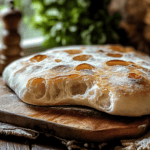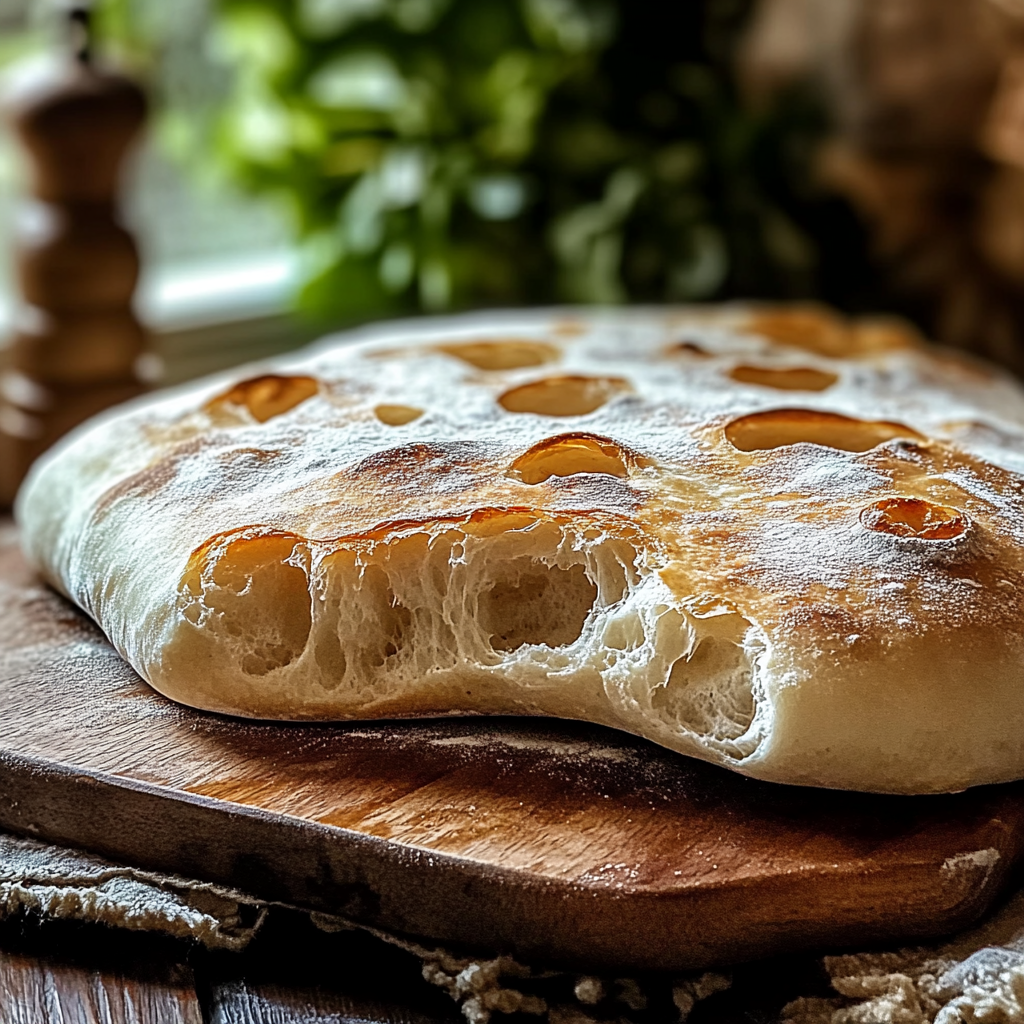Quick Overview
If you’re looking for a delightful homemade treat, our guide to the best ciabatta recipe is just what you need. This traditional Italian bread offers a crispy crust and an airy interior that pairs wonderfully with various dishes. With just a few simple ingredients and some patience, you can create a loaf that will impress your family and friends. Let’s jump into the details of crafting this beautiful bread right in your own kitchen!
Ingredient Breakdown
H4 Flour
For this recipe, you’ll need 500 grams of strong white bread flour. Strong flour contains a higher protein content which helps develop gluten for that perfect chewy texture.
H4 Water
Use 400 ml of lukewarm water. The temperature should be around 37°C (98°F). Warm water helps activate the yeast more effectively.
H4 Yeast
Add 7 grams of active dry yeast or one packet. Yeast is essential for fermentation, which gives the bread its rise and texture.
H4 Salt
Incorporate 10 grams of sea salt. Salt enhances flavor and regulates yeast activity during fermentation.
H4 Olive Oil
Include 30 ml of extra virgin olive oil. This ingredient adds richness and contributes to a lovely crust when baked.
Step By Step Recipe: The Best Ciabatta Recipe
H4 Prepare the Dough
In a large bowl, mix the flour and salt together well. In a separate bowl, combine lukewarm water and yeast; let it sit for about five minutes until frothy. Gradually add this mixture into the flour while stirring continuously until everything combines into a sticky dough.
H4 Knead the Dough
Transfer the dough onto a floured surface and knead gently for about eight minutes. Avoid heavy kneading as this dough is quite wet; instead, stretch and fold it over itself repeatedly until it becomes smooth and elastic.
H4 First Rise
Place the kneaded dough in a lightly oiled bowl and cover with a damp cloth or plastic wrap. Let it rise in a warm area for about two hours or until doubled in size. This period allows flavor development through fermentation.
H4 Shape the Loaves
Once risen, gently turn the dough onto a floured surface without deflating it too much. Divide it into two equal pieces using a bench scraper or knife. Shape each piece into a rectangle by folding over edges toward the center; keep them dusted with flour to prevent sticking.
H4 Second Rise
Transfer the shaped loaves onto floured baking parchment on a tray. Cover them loosely with oiled plastic wrap or another cloth and allow them to rise again for approximately 45 minutes.
H4 Preheat Your Oven
While your loaves are rising, preheat your oven to 220°C (428°F). Placing an empty tray at the bottom of your oven will help create steam when baking—an essential step for achieving that perfect crust.
H4 Bake the Ciabatta
Once your oven is hot and your loaves have risen nicely, carefully transfer them into the oven on their parchment paper. Pour boiling water into the empty tray at the bottom to create steam and bake for 25-30 minutes until golden brown.
H4 Cool Before Slicing
Remove the loaves from the oven once they are nicely browned and sound hollow when tapped on their base. Allow them to cool on wire racks before slicing—this helps maintain their structure and texture.
Serving and Storing Tips
H4 Serving Suggestions
Ciabatta is versatile! Serve it warm with olive oil and balsamic vinegar as an appetizer or use it for sandwiches filled with fresh ingredients like mozzarella, basil, tomatoes, or cured meats.
H4 Storing Leftovers
To store leftover ciabatta, wrap it in paper towel followed by plastic wrap to retain moisture but prevent sogginess. Keep at room temperature for up to three days or freeze slices in airtight bags for longer storage—up to three months works well!
This recipe provides all you need to enjoy fresh homemade ciabatta right from your kitchen! Enjoy every bite!
Mistakes to Avoid
One common mistake when making the best ciabatta recipe is using the wrong flour. Always opt for high-protein bread flour, as it provides the strength needed for proper gluten development. All-purpose flour may yield a denser loaf, which lacks the characteristic airiness of ciabatta.
Another mistake is not allowing enough time for fermentation. The dough needs to rise properly to develop flavor and texture. Skipping this step can result in flat, dense bread. Patience is key; let your dough rest until it has doubled in size.
Failing to handle the dough gently can also lead to disappointing results. Overworking the dough destroys the air pockets you’ve created during fermentation. Use a light touch when shaping and folding your dough to maintain its airy structure.
Lastly, neglecting proper hydration can hinder your ciabatta’s crust and crumb structure. Ciabatta requires a wet dough for optimal results, so don’t shy away from adding water. Too little moisture will create a dry loaf with a poor texture.
Tips and Tricks
To master the best ciabatta recipe, start by measuring your ingredients accurately. Baking is a science, and even small discrepancies can affect the final product. Use a kitchen scale for precision when measuring flour and water.
For optimal texture, consider using a pre-ferment like biga or poolish. These mixtures enhance flavor and improve dough structure by giving the yeast a head start. Mix equal parts water and flour with a small amount of yeast, then let it sit overnight before incorporating it into your main dough.
The temperature of your environment also affects dough fermentation. Warmer kitchens speed up yeast activity, while cooler spaces slow it down. If your kitchen is cold, consider placing your dough in an oven with just the light on or near a warm spot in your home to promote rising.
Shaping ciabatta can be tricky due to its wet nature. Flour your work surface generously, and use a bench scraper to handle the sticky dough without deflating it too much. Dusting your hands with flour can also help you shape without sticking.
Lastly, bake ciabatta on a preheated baking stone or steel if possible. This method helps achieve that crispy crust you desire by providing consistent heat from below, allowing for better oven spring as well.
Suggestions for The Best Ciabatta Recipe
For an authentic flavor in your ciabatta, consider adding herbs or spices to the dough during mixing. A teaspoon of dried oregano or rosemary can impart delightful nuances without overpowering the bread’s natural taste.
Experiment with different types of olives or sun-dried tomatoes mixed into the dough for added flavor complexity. These ingredients not only enhance taste but also add visual appeal with their vibrant colors.
If you’re feeling adventurous, try incorporating cheese into your ciabatta recipe. A handful of grated Parmesan or crumbled feta adds richness that pairs beautifully with soups and salads.
Make sure to serve your freshly baked ciabatta with high-quality olive oil or balsamic vinegar for dipping. This simple accompaniment elevates your bread experience, making it perfect for sharing at gatherings.
Finally, store leftover ciabatta properly by wrapping it in parchment paper rather than plastic wrap to maintain its crusty exterior while avoiding sogginess.
FAQs
What makes ciabatta different from other breads?
Ciabatta stands out due to its unique texture and shape. It has a crisp crust and an open crumb structure filled with irregular holes, achieved through high hydration levels in the dough and minimal handling during shaping.
How long does the best ciabatta recipe take to prepare?
From start to finish, making ciabatta typically takes around 24 hours due to fermentation times required for optimal flavor development. However, active preparation time is only about 30 minutes spread throughout this period.
Can I freeze my homemade ciabatta?
Yes! Freezing homemade ciabatta is possible without sacrificing quality. Allow it to cool completely after baking before wrapping it tightly in foil or plastic wrap and placing it in an airtight container for up to three months.
Why did my ciabatta not rise properly?
If your ciabatta fails to rise adequately, check if your yeast is fresh and active before starting the recipe. Additionally, ensure that you allowed enough time for fermentation; under-fermented dough will not have developed sufficient gluten structure.
What should I serve with my fresh ciabatta?
Ciabatta pairs wonderfully with various dishes such as soups, salads, and charcuterie boards. You can also enjoy it simply dipped in olive oil or spread with butter or cheese for a delicious snack any time of day.
Can I use whole wheat flour instead of white flour?
While you can substitute whole wheat flour in part of your ciabatta recipe, using only whole wheat may result in denser bread due to lower gluten levels compared to white bread flour. Consider blending both types for balance.
Summary
In summary, mastering the best ciabatta recipe involves avoiding common mistakes like incorrect flour usage and poor fermentation practices while implementing useful tips such as precise measurements and strategic shaping techniques. Experimenting with flavors can elevate this classic bread even further while ensuring proper storage keeps leftovers fresh longer enhances enjoyment over time.

The Best Ciabatta Recipe for Perfect Bread
Description
If you’re looking for a delightful homemade treat, our guide to the best ciabatta recipe is just what you need. This traditional Italian bread offers a crispy crust and an airy interior that pairs wonderfully with various dishes. With just a few simple ingredients and some patience, you can create a loaf that will impress your family and friends. Let’s jump into the details of crafting this beautiful bread right in your own kitchen!
Ingredients
H4 Flour
For this recipe, you’ll need 500 grams of strong white bread flour. Strong flour contains a higher protein content which helps develop gluten for that perfect chewy texture.
H4 Water
Use 400 ml of lukewarm water. The temperature should be around 37°C (98°F). Warm water helps activate the yeast more effectively.
H4 Yeast
Add 7 grams of active dry yeast or one packet. Yeast is essential for fermentation, which gives the bread its rise and texture.
H4 Salt
Incorporate 10 grams of sea salt. Salt enhances flavor and regulates yeast activity during fermentation.
H4 Olive Oil
Include 30 ml of extra virgin olive oil. This ingredient adds richness and contributes to a lovely crust when baked.

